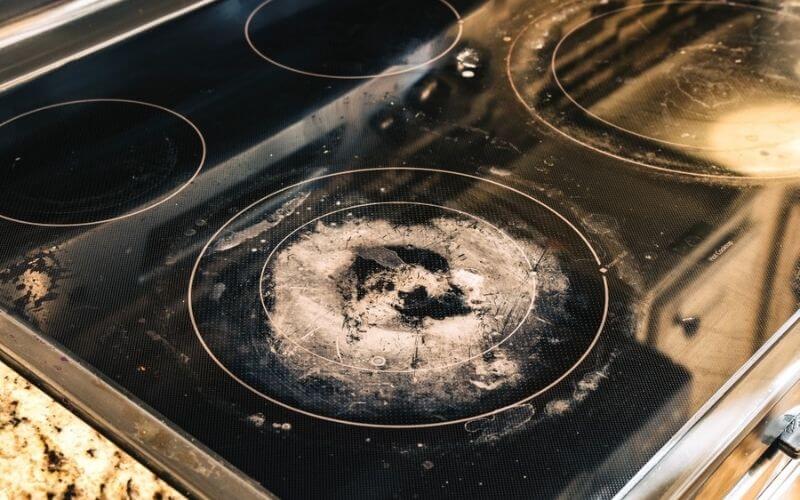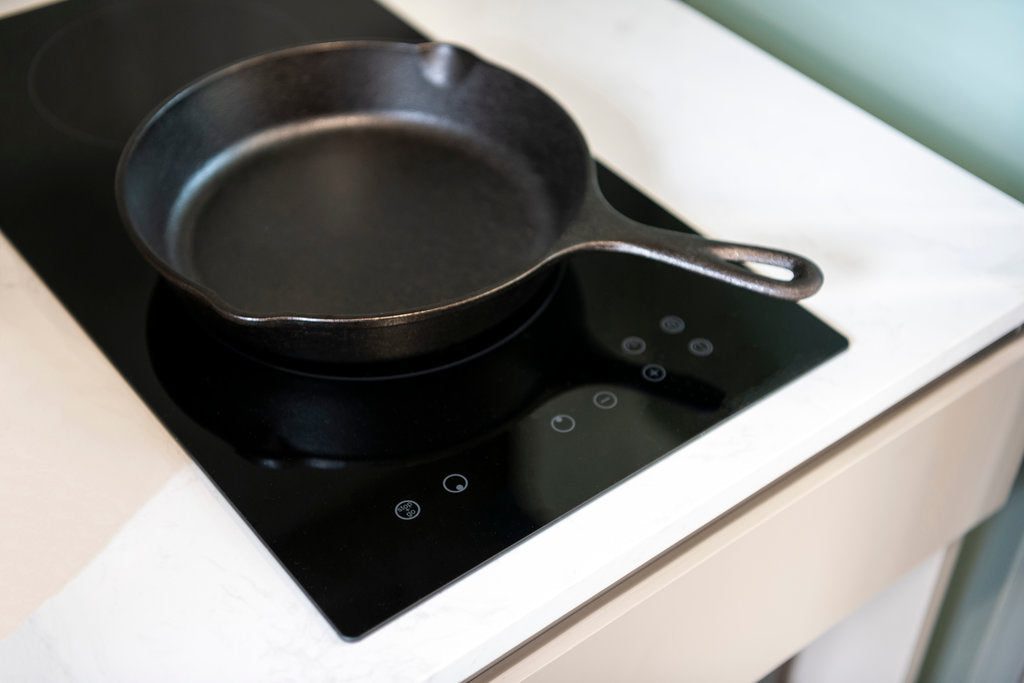If you have an induction cooktop, you know that it’s a great way to cook food quickly and evenly. But did you know that you need to take special care of your induction cooktop to keep it working properly? Here are some tips on how to protect your induction cooktop from cast iron:
Cast iron is a very popular material for cooking pots and pans, but it can actually damage your induction cooktop if not used correctly. Cast iron gets extremely hot when placed on an induction cooktop, so it’s important to use a diffuser plate between the pan and the cooktop. This will help distribute the heat evenly and prevent the cast iron from damaging thecooktop.
- Wipe the cooktop with a damp cloth to remove any debris
- Place a layer of foil over the cooktop
- Place a layer of wax paper over the foil
- Place your cast iron skillet on top of the wax paper
- Turn on the induction cooktop to the desired temperature and cook as usual
Lakeland Induction Hob Protector Liner
Does Cast Iron Scratch Induction Cooktop?
If you’re like most people, you probably think that cast iron is the cookware of choice for induction cooking. After all, it’s been around for centuries and is known for its durability. However, what you may not know is that cast iron can actually scratch your induction cooktop.
Here’s what you need to know about using cast iron on an induction cooktop, as well as some tips on how to avoid scratches.
Cast iron is a great material for cooking, but it’s important to remember that it is a bit harder than other materials like ceramic or glass. This means that if you drag your pan across the surface of your induction cooktop, it’s likely to leave behind scratches.
In addition, if you place a hot pan down on the surface without using a trivet or similar object, there’s also a chance that you’ll end up with scratches. So, if you’re going to use cast iron on an induction cooktop, be sure to take care in handling it so as not to damage the surface.
There are a few things that you can do to help avoid scratches when using cast iron on an induction cooktop.
First of all, make sure that the bottom of your pan is smooth before setting it down on the surface. If there are any rough spots or bumps, they could catch on the cooktop and cause scratching. In addition, always use a trivet or hot pad when placing a hot pan down on the surface.
This will help protect against accidental scratches from happening. Finally, be careful when dragging pans across the surface – try not to slide them too much so as not to damage the finish.
Overall, while cast iron can scratch an induction cooktop if not used properly, there are ways to avoid this problem by taking care in how you handle and use your pots and pans.
By following these simple tips, you can enjoy cooking with this durable material without worry about damaging your investment into an induction range!
How Do I Keep My Induction Cooktop from Scratching?
An induction cooktop is a smooth ceramic glass surface with an electromagnetic coil beneath it. When an iron or steel pot is placed on the cooktop, the magnetic field induces a current in the pot, which heats it up. Because there is no direct contact between the cooktop and the pot, there is no risk of scratching the cooktop.
To keep your induction cooktop from scratching:
1. Use only induction-safe cookware. This means that the bottom of the pan must be flat and made of a ferromagnetic material like cast iron or stainless steel.
If you’re not sure if your pan will work with an induction cooktop, try holding a magnet to the bottom of it – if it sticks, it’s likely that it will work with induction.
2. Avoid using sharp objects on the surface of the cooktop. This includes things like knives and metal spatulas, which can scratch or damage the surface.
Stick to using plastic or silicone utensils instead.
3. Don’t slide pots and pans across the surface of the cooktop – lift them up when you need to move them around. Again, this will help avoid scratches on the smooth ceramic glass surface.
4. Clean spills promptly – if something is spilled on your induction cooktop, wipe it up right away before it has a chance to harden and become difficult to remove (this goes for both food and liquid spills). A soft cloth dampened with soapy water should do the trick in most cases; more stubborn stains may require special cleaners designed for use on glass surfaces (such as Cerama Bryte).
Can You Use a Silicone Mat on an Induction Cooktop?
The short answer is yes, you can use a silicone mat on an induction cooktop. However, there are a few things to keep in mind when using one.
First, make sure that the silicone mat is heat-resistant.
Not all mats are created equal and some may not be able to withstand the high temperatures of an induction cooktop.
Second, pay attention to the size of the mat. It should be large enough to cover the entire cooking surface, otherwise it won’t do much good.
Third, consider how thick the mat is. Thinner mats will heat up more quickly, so they’re better for quick cooking tasks. thicker mats will take longer to heat up but will retain heat better, making them ideal for slow cooking or simmering.
Finally, keep an eye on the condition of your silicone mat. If it starts to show signs of wear or tear (like cracks or holes), it’s time to replace it.
So there you have it!
You can absolutely use a silicone mat on an induction cooktop – just make sure you choose one that’s made specifically for this purpose and keep an eye on it while you’re cooking.


Credit: boatbasincafe.com
Induction Cooktop Scratch Protector
If you have an induction cooktop, you know how convenient it is to use. But, did you know that you can get a scratch protector for your induction cooktop?
A scratch protector is a clear film that goes over your cooktop and protects it from scratches.
It’s easy to apply and remove, and it’s totally invisible once applied. Plus, it won’t affect the performance of your cooktop at all.
If you’re worried about scratching your induction cooktop, or if you just want to keep it looking new, pick up a scratch protector today.
You’ll be glad you did!
Will Cast Iron Scratch on Induction Cooktop
If you’re considering using cast iron cookware on an induction cooktop, you may be wondering if the cookware will scratch the surface. While it’s possible that your cookware could eventually scratch the glass surface of your induction cooktop, it’s not likely to happen with normal use. However, if you’re concerned about scratches, there are a few things you can do to help protect your cooktop.
First, make sure that your cast iron pan is properly seasoned. A well-seasoned pan will create a nonstick surface that is less likely to stick to the cooktop and cause scratches. If your pan is not properly seasoned, it’s more likely to stick and cause scratches when you try to remove it from the cooking surface.
Second, use a soft cloth or silicone spatula when removing food from the pan. Avoid using metal utensils that could potentially scratch the cooktop surface.
Finally, don’t slide your pan across the cooktop surface.
Instead, lift it straight up off of the burner. Sliding the pan across the surface could cause scratching over time.
How to Use Cast Iron on Induction Cooktop
If you’re lucky enough to have an induction cooktop in your kitchen, you may be wondering how to use your trusty cast iron skillet on this newfangled appliance. Luckily, it’s actually quite easy! Here’s what you need to know about using a cast iron skillet on an induction cooktop.
First of all, it’s important to make sure that your skillet is compatible with induction cooking. Most newer skillets should be fine, but if you’re not sure, just check the bottom of the pan for a magnet – if it sticks, then it will work on an induction cooktop.
Once you’ve confirmed that your skillet is compatible, simply place it on the cooktop and turn on the power.
Induction cooktops heat up quickly, so you’ll need to adjust your cooking time accordingly. Start with a lower heat setting and increase as needed.
As with any type of cooking, always use caution when working with hot surfaces.
But other than that, there’s really not much difference between using a cast iron skillet on an induction cooktop versus any other type of stove – so go ahead and enjoy your delicious meals!
Conclusion
If you’re using an induction cooktop, there are a few things you can do to protect it from cast iron. First, make sure the cooktop is clean and dry before using it. If there’s any moisture on the surface, it can cause the cast iron to stick.
Second, use a cooking spray or oil to lubricate the surface of the cooktop before placing the pan on it. This will help prevent sticking and make cleanup easier. Finally, be careful not to slide the pan across the cooktop; this can scratch the surface.

